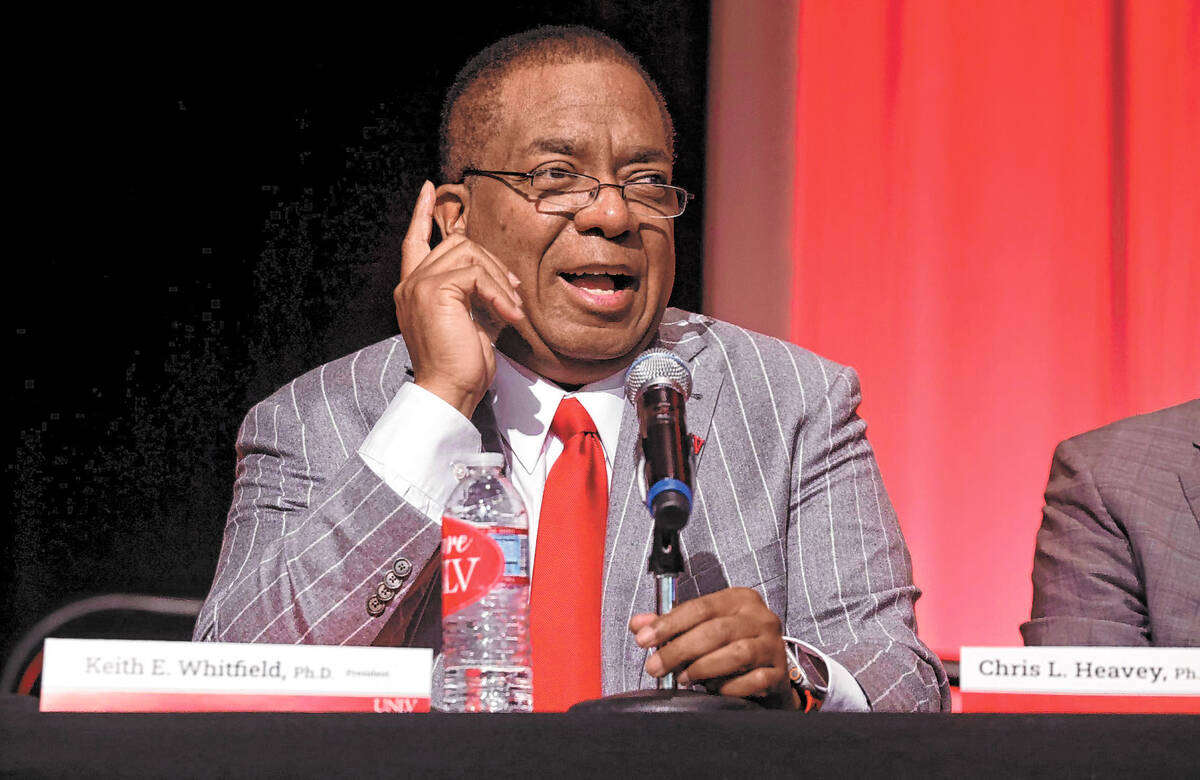Why such turnover for UNLV presidents? Some blame the Board of Regents
Keith Whitfield’s sudden departure from a 4½-year term as president of UNLV was nothing new for the university.
The last time UNLV had a president serve longer than five years was when Carol Harter was president from 1995 to 2006. Between her departure and Whitfield assuming the role in August 2020, there were five people who served as president or acting president. Each one held the role for just a few years.
Whitfield’s Monday night departure came at a critical time for UNLV. The Nevada Legislature, which allocates funding to the university, is currently in session — now with no permanent president to advocate on the university’s behalf.
As well, President Donald Trump’s pledge to abolish the U.S. Department of Education has rendered the future of federal education funding, which includes Pell Grants and research grants, uncertain.
Several university presidents, including Whitfield, according to some in the university community, have had a tumultuous relationship with the Nevada Board of Regents. The board, which oversees Nevada universities, has faced accusations of dysfunction and a lack of accountability, and has struggled to secure a permanent chancellor to oversee the Nevada System of Higher Education.
As it continues to be overseen by the regents, the future for UNLV — and its next president — remains unclear.
“I try to be hopeful, even though everything I’ve experienced says otherwise,” said Kris Engelstad, a longtime UNLV donor who pulled her funding in May 2024 due to what she called “adversarial behavior” behind closed doors from university leadership.
Over the course of the Engelstad Foundation’s long partnership with the school, it contributed about $43.5 million, with a notable $15 million donation for the construction of the Kirk Kerkorian School of Medicine main education building, which opened in 2022.
Criticizing the regents
In his resignation from his position as UNLV president seven years ago, Len Jessup cited NSHE’s governance structure as being a hindrance to long-term sustainability for any president. He said the nine months leading up to his resignation were fraught with “increased antagonistic, invasive, and consistent interference and animosity consistently expressed on behalf of the regents by various regents and the chancellor.”
“As evidenced by the constant change in leadership in the office of the UNLV President over the past decade, the current UNLV/NSHE governance structure makes long-term sustainability a challenge for any UNLV president,” Jessup wrote in his resignation letter in 2018.
Engelstad said the sentiment was “absolutely true.”
“(The regents) will not allow somebody to function as a full president,” she said Thursday. “If you’re hiring the right people, you should have some confidence.”
Engelstad said that the structure of the regents had changed since Jessup’s tenure, but that it still had a long way to go.
UNLV Professor Bill Robinson said that he thought the relationship between Whitfield and the regents had not been good for a while.
“Long term, probably there was going to be change soon,” Robinson said.
Regent Patrick Boylan said that he had seen an “impending divorce” between the regents and Whitfield.
The board has long been criticized for a lack of accountability to the Legislature.
In 2016, NSHE Chancellor Dan Klaich resigned after the Las Vegas Review-Journal reported on emails that revealed regents had misled lawmakers in 2011 and 2012 who were studying equity in distribution of state funding.
In November 2024, voters had the opportunity to remove the board’s constitutional designation, which supporters said would give the legislature more power over it. It failed by more than 116,000 votes, receiving 55 percent votes against and 45 percent votes in favor.
History of presidents
Before Whitfield’s 4½-year tenure, Marta Meana served as acting president for two years. She was appointed to the role in June 2018 and announced in February 2020 that she would not seek the permanent position.
“My plans do not align with UNLV’s need for a president who can make a commitment for an extended period of time,” she said at the time.
Jessup was president from 2015 to 2018. When she pulled her funding last year, Engelstad said that Jessup was the only president she got along with.
Donald Snyder was acting president for one year.
Neal Smatresk was president from 2009 until he left to become president at the University of North Texas in 2014.
David Ashley was president for three years before him. The regents voted him out in 2009 after a meeting that included over six hours of mostly negative testimony, the Review-Journal reported.
Harter was the first woman to hold the top job at UNLV, serving for 11 years, from 1995 to 2006. During her tenure, Harter oversaw the construction of 17 buildings on the campus, including the Lied Library, according to the university.
Moving forward
UNLV Executive Vice President and Provost Christopher Heavey, who has been at UNLV for three decades, will serve as officer in charge of UNLV, NSHE announced Tuesday. Heavey was a finalist for the role in 2020, when Whitfield ultimately got the job.
Going forward, Engelstad said, Heavey should treat his role like a job interview.
For now, Englestad said she had no plans to give money to UNLV. She described having one president after another coming to her with a new vision, but said it always ends up being the same. She said she would see what Heavey, or whoever assumes the permanent position, does within the next few years.
But Engelstad has high hopes for the university, which U.S. News & World Report currently puts at 135 in its ranking of U.S. public universities.
“I think our students deserve better, so why do we settle?” Engelstad said.
Contact Katie Futterman at kfutterman@reviewjournal.com. Follow @ktfutts on X and @katiefutterman.bsky.social.


















